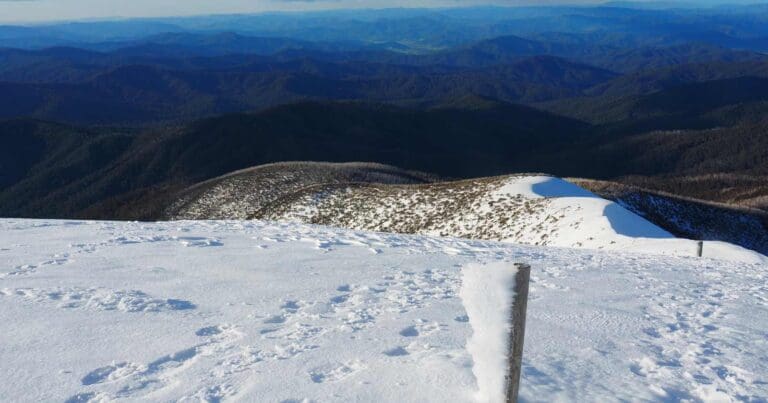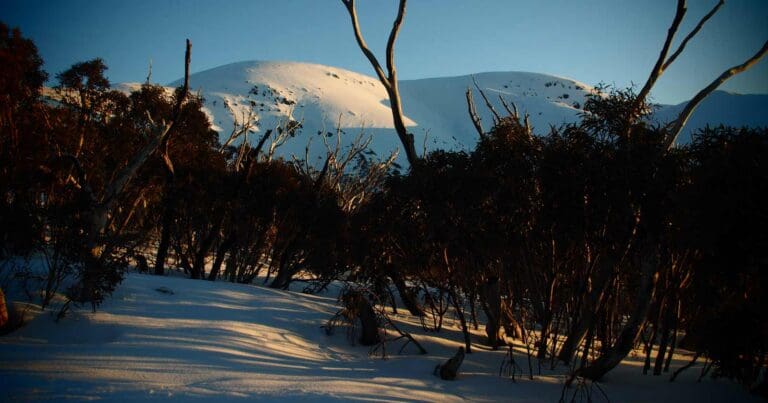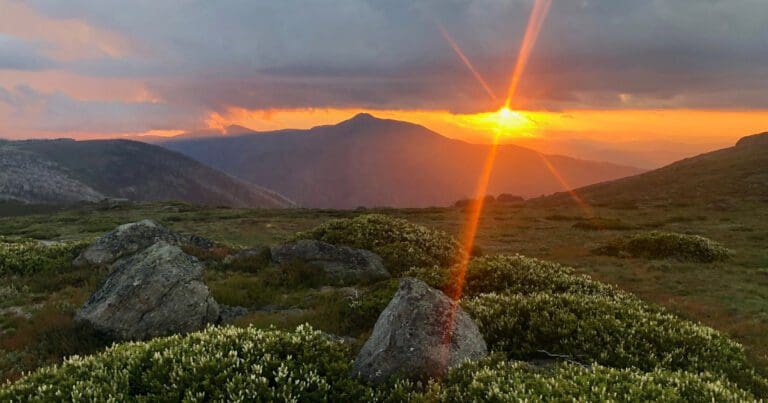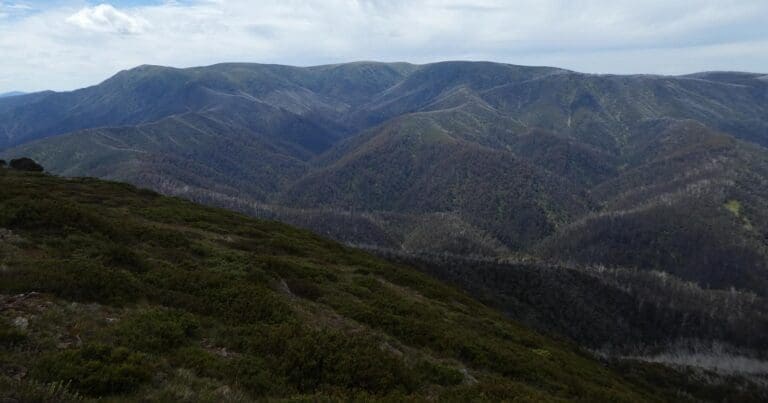Hike at a Glance
Max elevation: 1979m
Min elevation: 595m
Total Ascent: 4394m
Important info
The hike is strenuous and requires a good level of fitness. The hike is exposed and there is little shelter from the elements. During the winter months you should consider this a Grade 5 hike. Weather conditions can change rapidly and without warning in the alpine region. Be prepared and check conditions before you go.
Hike overview
This 77-kilometre multi-stage hike from Mountain Creek Campground, north-west of Mount Beauty, to Diamantina Hut, west of Hotham Village, takes in the towering peaks of Mount Bogong and Mount Feathertop. It offers a rewarding challenge for experienced hikers and trail runners alike, passing through some of the most scenic and rugged terrain in the Victorian Alps. The trail features a mix of tough ascents, stunning alpine landscapes, and secluded campsites, making it an unforgettable journey for those looking for adventure.
Stage 1: Mountain Creek to Cleve Cole Hut (12.5km)
Starting at Mountain Creek, this first stage sets the tone with a challenging climb up Staircase Spur to the summit of Mount Bogong. After a car shuffle or return transport (as this is a one-way hike), the ascent begins. The climb takes around five to six hours, with some tough sections, but the spectacular views from the summit are well worth the effort, especially after breaking the treeline at 1700 metres. The descent to Cleve Cole Hut via Hell Gap offers a welcome change in pace. At the hut, the scenery continues to impress, with the surrounding saddle providing an ideal camping spot. The warmth of the hut’s fire offers much-needed respite after a long day of hiking.
Stage 2: Cleve Cole Hut to Ropers Hut (12km)
The second stage brings more challenges as the trail descends to Big River, passing Howman’s Falls along the way. The descent is long and tiring, but the river crossing is straightforward, with a chain for support. The real test comes with the steep climb on the opposite side, gaining around 700 metres of elevation in just a few kilometres. Upon reaching Ropers Hut, the setting among the snowgums provides a peaceful and quiet atmosphere. The nearby creek is perfect for gathering water or enjoying a refreshing wash after the hard climb.
Stage 3: Ropers Hut to Cope Hut (16.5km)
Stage three eases the pace somewhat with a 17-kilometre trek towards Cope Hut. This section is largely on fire trails, offering a gentler walk compared to the previous stages' constant elevation changes. The views of Mount Bogong behind and Mount Feathertop ahead make for a relaxing and scenic stretch. A great camping spot lies near the snowgums south of Cope Hut, ideal for those looking to immerse themselves in the tranquility of the alpine environment.
Stage 4: Cope Hut to Blairs Hut (14km)
Stage four brings another enjoyable stretch, crossing the high plains with stunning views of alpine hovea and starbush, particularly at sunrise. The walk is a mix of flat sections and gentle inclines, with a highlight being the view of Mount Feathertop from the rise near Pole 333. During this stage, hikers will pass Westons Hut, before continuing to Blairs Hut for the night, where a peaceful camping experience awaits.
Stage 5: Blairs Hut to Federation Hut (11km)
The fifth stage begins with a crossing of the Kiewa River, followed by the steep ascent of the infamous Diamantina Spur. This track climbs sharply west from the Kiewa River West Branch, ascending for 4 kilometres before joining the South Razorback track at High Knob, about 3 kilometres from the summit of Mount Feathertop. The trail offers incredible views of Mount Feathertop but involves some tough and steep sections, including scrambling over loose shale. There is no water on Diamantina Spur, so ensure to collect enough water before starting the ascent. Once on the South Razorback, the track becomes gentler as it heads north, passing Molly Hill to the Memorial Cross Junction. From here, you can either turn right to summit Mount Feathertop or head left to Federation Hut. Federation Hut provides a comfortable base for the night, equipped with a wood fire and a water tank. Excellent campsites can be found outside the hut, as camping inside is not permitted. A nearby composting toilet adds extra convenience.
Stage 6: Federation Hut to Diamantina Hut (11km)
The final stage crosses the Razorback, a high ridge linking Mount Feathertop to Mount Hotham. This exposed track provides panoramic views, but it can be hazardous in poor weather conditions. When conditions allow, the breathtaking views across the surrounding peaks make it one of the most scenic parts of the journey. The ridge walk provides a fitting and dramatic end to the traverse, concluding this memorable and challenging hike through the Victorian Alps.
This route through the Victorian Alps is an excellent choice for hikers and trail runners looking for a multi-stage adventure in one of Australia's most spectacular alpine regions. Whether you’re hiking over several days or running it in one go, the variety of terrain and awe-inspiring landscapes will leave you with lasting memories of your time in the mountains.
Tips
- Check road conditions before you travel, especially in winter, as snow, ice, and other weather can impact access.
- Be prepared for sudden weather changes; alpine conditions can shift quickly, so always carry appropriate clothing and gear.
- Dress in layers to stay comfortable in changing temperatures.
- Carry extra food and water, as resupply options can be limited in remote alpine areas.
- Ensure your footwear is sturdy and waterproof for rough, slippery terrain.
- Know the trail conditions, as snow, ice, or mud can make paths more challenging.
- Use sun protection at higher altitudes to prevent sunburn.
- Carry a map, compass, or GPS in case visibility is poor due to fog or cloud cover.
- Stay aware of your surroundings and be cautious of steep slopes and loose rocks.
- Check avalanche risks in winter or early spring, particularly in exposed areas.
Gallery
Got some great shots from this hike? Upload your photos here to inspire others and show off the beauty of the trail!
Click to view form >>
Submitting your photos doesn’t mean you lose ownership. You can be credited for your contributions, and you can request removal at any time.
Content use
Please don’t copy GPX files or content from this site to AllTrails or other platforms. Each trail has been personally mapped, documented, and refined to support Australia’s bushwalking and hiking community. While some details come from land managers, every listing reflects significant personal effort. This is a free, community-driven initiative—your respect helps keep it that way.
Walk map and GPX file
Max elevation: 1979 m
Min elevation: 595 m
Total climbing: 4394 m
Total descent: -3272 m
Getting there
Getting to the trailhead: Alpine National Park.
The Bogong to Hotham Traverse, as described here, commences at Mountain Creek Campsite, north-west of Mount Beauty, and ends at Diamantina Hut on the Great Alpine Road. It can also be completed in the opposite direction, so directions to both the north and south trailheads are provided below.
From the North – Mountain Creek Campsite
To start the hike at Mountain Creek Campsite, head to the small town of Tawonga, which is located about 4 km north of Mount Beauty. From Tawonga, take Mountain Creek Road east for approximately 10.5 km. The campsite is situated at the end of this road and offers pleasant campsites with a pit toilet for basic facilities. The Mountain Creek Campsite serves as the ideal starting point for the hike, and there is ample space for parking.
From the South – Diamantina Hut
To reach the trailhead at Diamantina Hut, drive to Hotham Village, located along the Great Alpine Road. From Hotham Village, continue heading east on the Great Alpine Road towards Harrietville. The Diamantina Hut trailhead is located about 2.5 km from the village, on the Harrietville side of the village. Watch for the signposting along the road to Diamantina Hut, which marks the starting point of the trail.
Note: It’s highly recommended to check road conditions before you travel, especially during the winter months, as snow, ice, and other weather conditions can impact access to the area. Be prepared for possible closures or delays due to adverse weather.
Closest towns to this walk: Benalla, Bright, Dinner Plain, Falls Creek, Harrietville, Hotham Heights, Mansfield, Mitta Mitta, Mount Beauty, Mount Hotham, Myrtleford, Omeo, Porepunkah, Tawonga South, Wangaratta
About the region
Exploring Australia's Alpine National Park
The Alpine National Park offers a range of exciting outdoor activities that cater to all levels of adventure. Located in Victoria, this park is home to some of the state's highest mountain ranges, making it a popular destination for bushwalkers, hikers, and nature lovers. The park’s stunning landscapes are perfect for exploring on foot, on horseback, or even by mountain bike, with plenty of world-class trails to enjoy.
For a truly memorable experience, try the Falls to Hotham Alpine Crossing, which takes you across towering alpine ridgelines and through lush river valleys, all set against breathtaking alpine scenery. If you're looking to learn about the region's history, you can drive along the Wonnangatta Four-wheel Drive route, where you'll uncover the stories of the past while taking in rugged bushland and mountain views. For those keen on a challenge, the Razorback Ridge hike leads to Victoria’s second-highest peak, Mount Feathertop, offering some of the most spectacular views of the Great Dividing Range.
Adventurers can also take on the challenge of climbing Mount Bogong, the highest peak in Victoria, or explore the historic huts scattered across the Bogong High Plains, once home to legendary cattlemen. For a thrill of a different kind, white-water rafting trips on the Mitta Mitta River or skiing across the park’s varied terrain can help you experience the park’s wild side. Whether you prefer downhill runs or cross-country trails, the Alpine National Park offers some of the best ski touring opportunities in the state.
The park is also an important part of the Aboriginal cultural landscape, with traditional Country belonging to the Taungurung and Gunaikurnai Peoples.
Want to find the best trails in Alpine National Park for an adventurous hike, casual walk, or a family trip? Trail Hiking Australia has the best trails for walking, hiking, running, and more.
Similar walks nearby
Looking for more walks in or near Alpine National Park? Try these trails with a similar difficulty grade.
Track grade
Grade 4 (Hard) - Challenging Walks for Experienced Walkers: Grade 4 on the AWTGS signifies challenging walking tracks. Bushwalking experience is recommended for these tracks, which may be long, rough, and very steep. Directional signage may be limited, requiring a good sense of navigation. These walks are suited for experienced walkers who are comfortable with steeper inclines, rougher terrain, and potentially longer distances.
Explore safe
Plan ahead and hike safely! Carry enough water, pack layers for changing conditions, and bring safety gear like a torch, PLB, and reliable communication device. Check official sources for trail updates, closures, and access requirements, and review local weather and bushfire advice. Most importantly, share your plans with someone before you go. Being prepared makes for a safer and more enjoyable hike! Stay Safe, Explore More, and Always #ExploreSafe.
Packing checklists
What you carry in your pack depends on factors like weather, terrain, and your adventure type. Not sure what to bring? My free planning, food, and packing checklists are a great starting point, covering day hikes, overnight trips, and multi-day adventures. Use them to customise your kit and always prioritise safety.
Let someone know
Before heading out, take a moment to fill out your trip intentions form. It’s a quick way to share your hike details with family or friends. If something goes wrong, they can notify emergency services, ensuring a faster response and peace of mind. Stay safe and enjoy your adventure
Suggest an edit
Spotted a change on this trail? Maybe there are new features, the route has shifted, or the trail is permanently closed. Whatever the update, I’d love your input. Your feedback helps fellow hikers stay informed and ensures that our trail info stays fresh and reliable.
Acknowledgement of Country
Trail Hiking Australia acknowledges the Traditional Owners of the lands on which we hike and pay respects to their Elders, past and present, and we acknowledge the First Nations people of other communities who may be here today.






